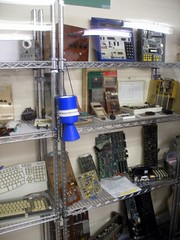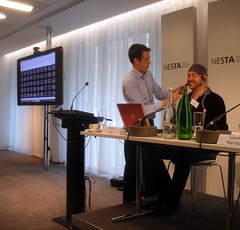My talk at LIFT 2014 Basel, <a href=”http://videos.liftconference.com/video/10528321/anders-sandberg-the-man-machine-are”>The Man-Machine: Are we living in the 1970s of brain hacking?</a> can now be viewed online (slides (pdf)).
My basic thesis is that the late 70s and early 80s microcomputer revolution might be a useful analogy for what might be happening with neurohacking today: technology changes are enabling amateur and startup experimentation that will in the long run lead to useful, society-changing products that people grow up with and accept. 20 years down the line we may be living in an enhanced society where some of the big neuro-players started up in the near future and became the Apple and Microsoft of enhancement.
A bit more detail:
 In the 70s the emergence of microprocessors enabled the emergence of microcomputers, far cheaper than the mainframes and desk-sized minicomputers that had come before. They were simple enough to be sold as kits to amateurs. The low threshold to entry led to the emergence of a hobbyist community, small start-ups and cluster formation (helped by the existence of pre-existing tech clusters like Silicon Valley). The result was intense growth, diversity and innovation. The result was a generation exposed to the technology, accepting it as cool or even ordinary, laying the foundation for later useful social and economic effects – it took 20+ years to actually have an effect on productivity! Some things take time, and integrating a new technology into society may take a generation.
In the 70s the emergence of microprocessors enabled the emergence of microcomputers, far cheaper than the mainframes and desk-sized minicomputers that had come before. They were simple enough to be sold as kits to amateurs. The low threshold to entry led to the emergence of a hobbyist community, small start-ups and cluster formation (helped by the existence of pre-existing tech clusters like Silicon Valley). The result was intense growth, diversity and innovation. The result was a generation exposed to the technology, accepting it as cool or even ordinary, laying the foundation for later useful social and economic effects – it took 20+ years to actually have an effect on productivity! Some things take time, and integrating a new technology into society may take a generation.
Right now we have various official drivers for neural enhancement like concerns about an ageing society, chronic diseases, stress, lifelong learning and health costs. But the actual drivers of much of the bottom-up neurohacking seem to be exploration, innovation and the hacker ethos of taking something beyond its limits. Neurotechnologies may be leaving the confines of hospitals and becoming part of home or lifestyle technologies. Some, like enhancer drugs, are tightly surrounded by regulations and are likely to be heavily contested. Meanwhile many brain stimulation, neurofeedback and life monitoring devices exist in a regulatory vacuum and can evolve unimpeded. The fact that they are currently not very good is no matter: the 70s home computers were awful too, but they could do enough cool things to motivate users and innovation.
 Why is there a neurotech revolution brewing? Part of it is technology advances: we already have platforms like computers, smartphones, wifi and arduinos available, enabling easy construction of new applications. Powerful signal processing can be done onboard, data mining in the cloud. Meanwhile costs for these technologies have been falling fast, and crowdsourcing is enabling new venues of funding for niche applications. The emergence of social consumers allow fast feedback and customisation. Information sharing has become orders of magnitude more efficient since the 70s, and technical results in neuroscience can now easily be re-used by amateurs as soon as they are published (the hobbyists are unlikely to get fMRI anytime soon, but results gained through expensive methods may then be re-used using cheap rigs).
Why is there a neurotech revolution brewing? Part of it is technology advances: we already have platforms like computers, smartphones, wifi and arduinos available, enabling easy construction of new applications. Powerful signal processing can be done onboard, data mining in the cloud. Meanwhile costs for these technologies have been falling fast, and crowdsourcing is enabling new venues of funding for niche applications. The emergence of social consumers allow fast feedback and customisation. Information sharing has become orders of magnitude more efficient since the 70s, and technical results in neuroscience can now easily be re-used by amateurs as soon as they are published (the hobbyists are unlikely to get fMRI anytime soon, but results gained through expensive methods may then be re-used using cheap rigs).
It seems likely that at least some of these technologies are going to become more acceptable through exposure. Especially since they fit with the move towards individualized health concepts, preventative medicine and self-monitoring. The difference between a FitBit, a putative sleep-enhancing phone app, Google Glass and a brain stimulator might be smaller in practice than one expects.
 The technology is also going to cause a fair bit of business disruption by challenging traditional monopolies by enabling new platforms, new routes of distribution and access. The personal genomics battle between diagnostic monopolies and companies selling gene tests (not to mention individuals putting genetic information online) is a hint of what may come. Enhancement demands a certain amount of personalisation/fine tuning to work, and might hint of a future of ‘drugs as services’ – drugs may be part of a system of measurement, genetic testing and training rather than standalone chemicals.
The technology is also going to cause a fair bit of business disruption by challenging traditional monopolies by enabling new platforms, new routes of distribution and access. The personal genomics battle between diagnostic monopolies and companies selling gene tests (not to mention individuals putting genetic information online) is a hint of what may come. Enhancement demands a certain amount of personalisation/fine tuning to work, and might hint of a future of ‘drugs as services’ – drugs may be part of a system of measurement, genetic testing and training rather than standalone chemicals.
Still, hype kills. Neuroenhancement is still slowly making its way up the slope of the hype curve, and will sooner or later reach a hype peak (moral panics, cover of Time Magazine) followed by inevitable disappointment when it doesn’t change everything (or make its entrepreneurs rich overnight). Things tend to take time, and there will be consolidation of the neuromarket after the first bubble.
The long-run effects of a society with neuroenhancement are of course hard to predict. It seems likely that we are going to continue towards a broader health concept – health as an individual choice, linked to individual life projects but also perhaps more of an individual responsibility. Mindstates will be personal choices, with an infrastructure for training, safety and control. Issues of morphological freedom – the right to change onself, and the right not to have change imposed – will be important social negotiations. Regulation can be expected to lag as always, and usually regulate devices based on older and different systems.
Generally, we can expect that our predictions will be bad. But past examples show that early design choices may stay with us for a long time: the computer mouse has not evolved that far from its original uses at Bell Labs and Xerox Parc. Designs also contain ideology: the personal microcomputer was very much a democratisation of computing. Neurohacking may be a democratisation of control over bodies and minds. We may hence want to work hard at shaping the future by designing well today.
Hi Anders! Is it possible to protect people from abuse of neuro hacking? For example if some one wants to mimic your brain over Internet and interact AI?
One could likely split abuses of neurohacking into two groups: one is breaches of integrity where information is extracted from you without your permission, one is breaches where your mental processes are influenced without your permission.
The first group ranges from normal privacy breaches, like how Google and Facebook can potentially construct very elaborate profiles of us from the information we unwittingly give, over actually getting neural recordings (current non-invasive methods would be EEG or fMRI), to actual intracerebral recordings (state of the art would be microelectrode arrays). It is worth noticing that of these three groupings only the first can be done surrepticiously: you tend to notice when somebody does brain surgery on you, not to mention scarring etc. Protection from those methods is essentially all about protecting the person, not very different from preventing people stealing kidneys or forcing lie detectors on somebody.
It is the information leakage methods that can be truly hard to prevent, since we are releasing information with every action. This is where real new work needs to be done. Philosophically, the problem does not seem to be the information itself but the lack of personal control over where it is going: we usually do not mind if our personal information is used for general statistics or scientific research, but get rather upset when it ends up in the hands of moral busybodies, relatives or commercial interests.
The other category, actually putting stuff into the mind, is way harder. We do not have the means to do that beyond very loose modulation. The brain hacking I discussed in the talk would at most do TMS or tDCS, which changes the plasticity or excitability of parts of the cortex – potentially useful, but it does not carry much information. To actually get some information directly into the brain a multielectrode array might achieve a few hundred bits/s, but while this can help blind orient themselves or give clues for desired actions in rat experiments, it is too limited right now to do any messaging (the normal sensory channels have way larger bandwidth). I think the hacking one could do would be to affect emotional systems, but this requires very overt invasive methods – it is not subtle at all.
Looking at the history of the field (check out Moreno’s book “Mind Wars” for a nice overview of military attempts at using neuroscience) there is no shortage of attempts to “hack” brains, but all the most successful have been using fairly conventional methods of persuasion psychology rather than trying to do a low-level hack. In the future this might change, but I suspect that from a cost-effectiveness perspective we should be more worried about efficient data gathering of mouse and eye movement used to model our interests and then fed to advertising services.
Anders, I’m curios how funded are those sleep hacking devices, because scientific data (and you pointed out well) strongly proves that messing around with sleep can negatively affect your bio-chemistry. our bodies are adapted to run according to the circadian clock (if you’re familiar with it). And this fact alone totally disproves poly-phase sleep or sleeping less than needed.
Yes, I have myself argued (in my and Bostrom’s “Wisdom of Nature” paper) that messing with sleep has a lot of evolutionary adaptation against it. But we should not believe that the monophasic 8 hour sleep is the one and only way to sleep: there is some evidence that there have been alternatives historically. But, yeah, polyphasic is pretty far away from anything anybody was regularly doing.
However, note that funding doesn’t have to follow what is reasonable – there are plenty of kickstarters and government funding for silly or misguided projects.
I’ve also read something about people during the middle ages waking up at 2-3 AM, reading, having sex, or eating…then sleep again…this would be a bi-phasic approach to sleep which seems more rational..considering there was little exposure to artificial light back then (which is also a killer of melatonin, key player in many bio-chemical processes).
Anders, tell me how do you cope with the desire of acquiring knowledge on various topics at once? It’s very difficult to focus on a narrow range of topics when there’s so many to learn and to experiment with…I got this thought from your appearance in the Transhuman youtube video.
Yes, insatiable curiosity has a few drawbacks. My approach is to jump in wholeheartedly, using the interest to focus and avoid getting side tracked. Then I try to quickly make something useful from it – either it is interesting enough to maintain the focus, or it becomes a potential seed for future projects or joint projects with some co-author. Eventually I jump to something else – but I tend to exploit past interests as procrastination.